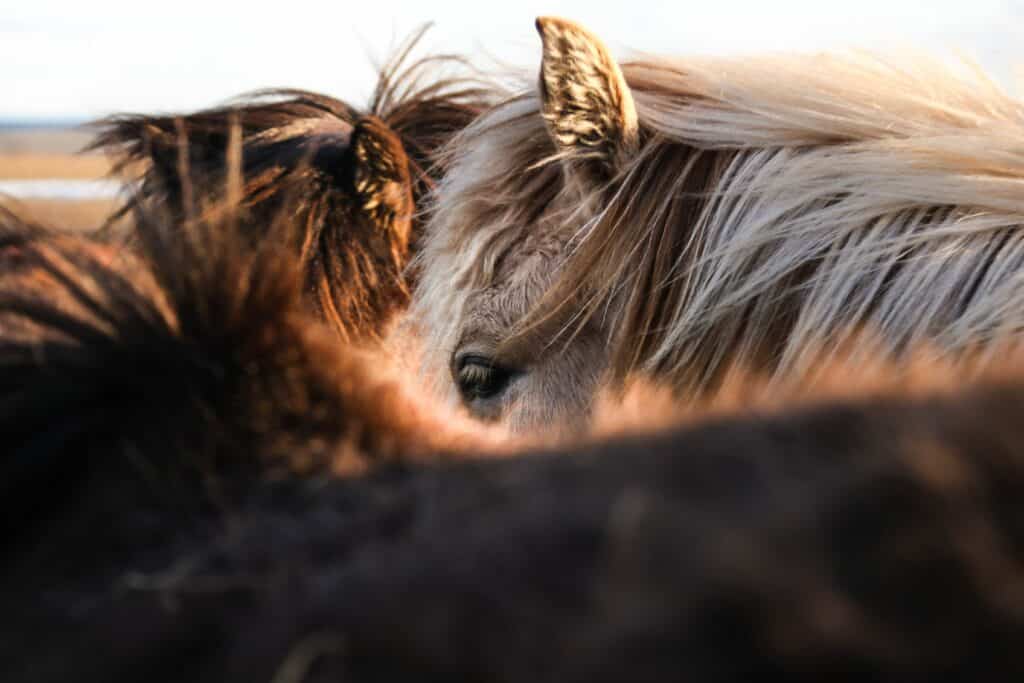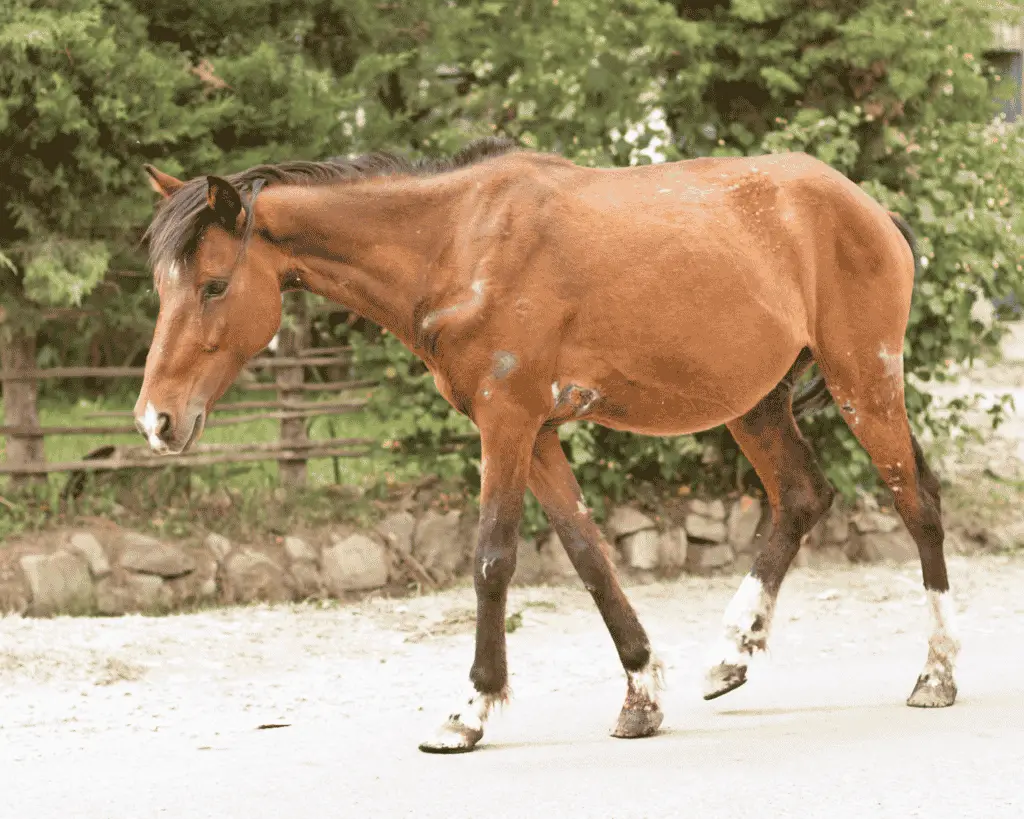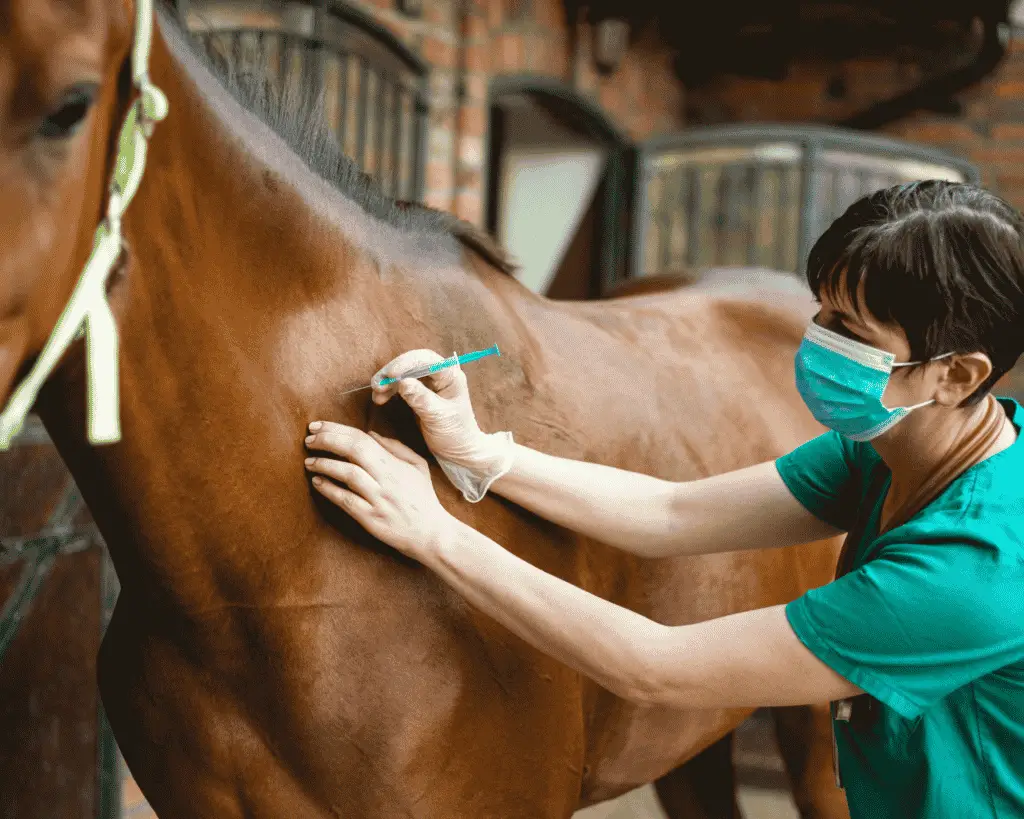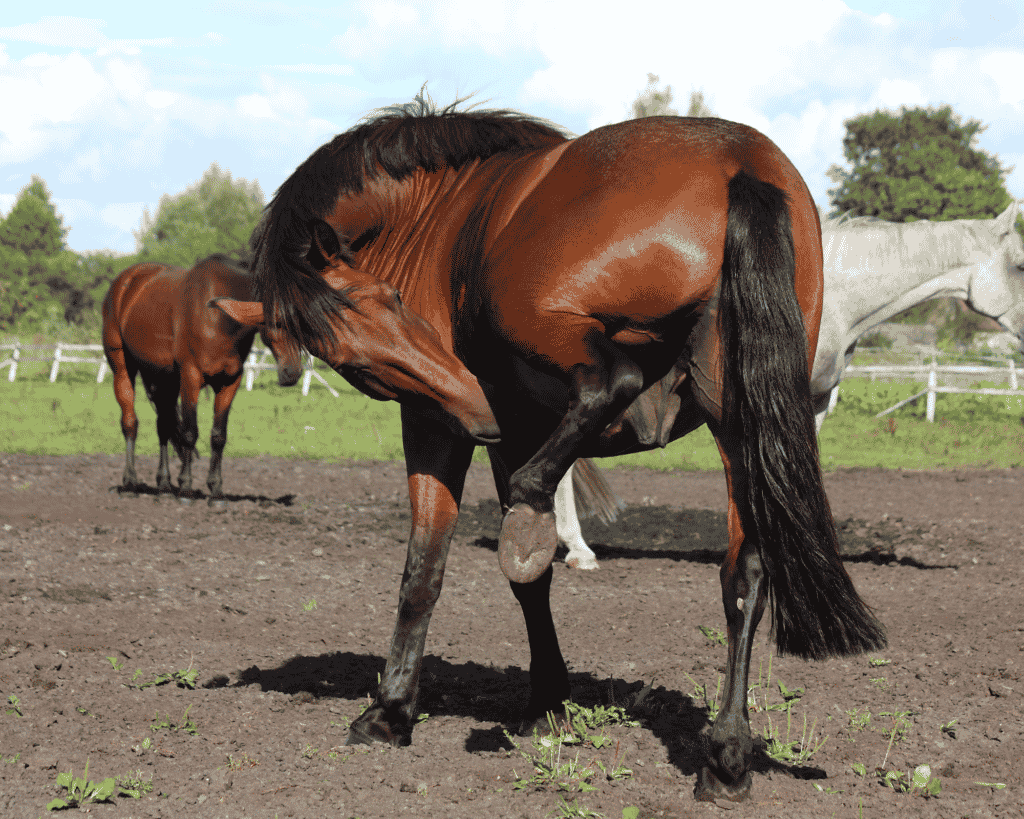Mange is a skin and coat condition that’s caused by mites and results in skin discomfort and hair loss. It’s not seen frequently in horses, but the right conditions can result in a mite infestation that requires aggressive treatment to resolve. At the heart of the issue with mange is the fact that it can be caused by multiple species of mites and each type of mite causes a specific type of mange.
All cases of horse mange cause the same type of symptoms in horses: relentless itching that causes a horse to scratch constantly, resulting in scabs, hair loss, and thickening or scarring of the skin. If it’s left untreated, mange will eventually spread over the entire body of a horse and leave them in a weakened state.
It’s important to get on top of a mite infestation as soon as you suspect there’s something going on with your horse’s skin. Horses who have mange may require additional treatment for the sores and scabs left behind in order to help the skin heal.
Mange used to be known as a reportable disease, which means that the federal government had to be informed when a veterinarian identified a case of mange. That requirement was ended in 2006 due to the fact that mange has become rare in horses in the U.S. through the use of anthelmintics. Anthelmintics, or de-wormers, are highly effective against mites and are one of the treatments used against them.
It’s important to keep in mind that early mange in horses can be mistaken for another skin condition. So, you’ll want to get a veterinarian’s opinion on the cause of your horse’s itchy situation as soon as possible to prevent further coat damage and provide relief from the relentless irritation.
Below you’ll find more information on what mange is, the different types of mange, symptoms to watch out for, along with prevention and treatment. As always, the information in this article is to be used as educational purposes only and you should always consult your veterinarian when it comes to your horse’s health and wellbeing.
What Causes Mange in Horses?
As previously mentioned, all cases of mange in horses are caused by mites. A horse usually picks up the mites by grazing in an area that contains a colony of mites. When the mites detect there is a suitable host in the vicinity, they launch themselves onto the horse and take hold.
Mites can also be transmitted from one horse to another when they come into close contact.
Once the mites have found their way onto the horse, they begin to bite and/or burrow into the skin to make a home for themselves. These actions cause intense itching and raised bumps. The horse’s scratching actions can cause these bumps to break open and bleed, and they eventually scab over.
As a general rule, horses and mites rarely connect with one another due to the development of anti-parasitic medications, but it’s not unheard of.

Different Types of Mange in Horses
The following is a look at the different types of mange mites and how they affect your horse’s skin and hair.
Chorioptic Mange (Legs)
This is the most common type of mange found in horses, with draft horses being most at risk of infestation. It’s also known as leg mange because it affects the legs of horses. Draft horses are most likely to pick up the Chorioptes bovis mite on their legs due to their feathering.
Sarcoptic Mange (Scabies or Body Mange)
It’s rare for horses to have sarcoptic mange, but it’s not unheard of. This type of mange is caused by the Sarcoptes scabies var equi mite. It’s the most severe type of mange a horse can have, and it’s caused by hypersensitivity to the saliva and feces of the mite. Lesions first appear on the head, neck, and shoulders, while areas with long hair (manes and tails) are usually left alone by the mites.
Psoroptic Mange (Mane)
This is one of the rarest types of mange in horses and has actually been eliminated in the United States. Psoroptic mange is caused by two types of mites that include Psoroptes ovis and P cuniculi. These mites are found infesting the forelock, mane, the base of the tail, between hindlegs, and udders. These mites prefer to take up residence in areas that are covered by thick hair.
Demodectic Mange
This type of mange is also rare. It’s caused by Demodex equi mites living in the oil glands and hair follicles of the eyelids and muzzle of a horse. The signs of a demodex mite infestation appear on the head, neck, shoulders, and front legs. A horse with demodectic mange presents with skin lumps, patchy areas of hair loss, and scaly skin.
Harvest Mites (Chiggers)
These mites are usually found on other mammals, but they’re not averse to infesting horses. They cause relentlessly itchy bumps and hives that have no specific treatment (although medication can control the itching). The signs of infestation appear in the late summer and fall, which gives the harvest mite its name.
Straw Itch Mites (Forage Mite)
The straw itch mite lives and feeds off straw and grain. An infestation occurs when a horse comes into contact with bedding and feed that’s contaminated by these mites. The signs of a straw mite infestation appear as bumps and hives on the muzzle, face, neck, and legs.

Signs and Symptoms of Mange in Horses
Most types of mange produce a common response of severe itching and discomfort in affected horses, while other types produce a condition that’s not immediately recognizable as mange. Chorioptic mites, for example, cause a condition known as “greasy heel” that manifests as itchy skin, loss of hair, and thickening of the skin. In contrast, trombiculoid mites, which are found living on plants, bite the lips, face, and feet of grazing horses with the bites causing itchy bumps.
You may not always spot the signs of early mange in horses. Horses are always looking to scratch an itch, and some tend to be itchier than others. However, mange puts them to their limits not long after infection, and they’ll engage in extreme scratching behavior. They’ll bite and rub their skin constantly and create hot spots that they won’t leave alone. These spots eventually lose hair and can form blisters and sores that weep and crust over.
You won’t be able to see the mites with your naked eye, but you can get a good sense of what’s causing your horse to itch so badly. Check the itchy area for signs that include:
- Sores
- Bumps
- Blisters
- Bald patches
- Thickened skin
- Itching
- Rash
- Redness
- Sores
These are the most common signs of mange in horses, and a horse can present with many of them at the same time. If you notice any of these signs, contact your vet for a diagnosis and treatment plan.

Treatment of Mange in Horses
Once you notice your horse is engaging in behaviors that indicate a persistent itch, you want to get to the bottom of their condition. An infestation of mites can cause the horse to scratch off its hair and result in physical weakness over time. The fastest way to get rid of mange in horses is to have a vet give your horse a physical examination and take a scraping of the affected area.
The vet will look at the scraping under a microscope to confirm the presence of a mite infestation, then prescribe appropriate treatment. However, in the case of sarcoptic mange, the mites may not be present, and the vet has to base their diagnosis on the signs. The type of treatment prescribed for mange depends on the type of mites that are present. They include:
- Lime-sulfur solution
- Acaracide wash
- Ivermectin administered orally or subcutaneously
- Moxidectin administered orally
- Permethrin
All of these treatments act fast on mange, with ivermectin considered the most effective treatment to get rid of mange in horses. However, oral ivermectin or moxidectin may not be sufficient for the complete eradication of mites and require additional topical treatment. Severe skin lesions may need secondary treatment in the form of an antibiotic.
In the event the horse is suffering severe itchiness from the mange, the veterinarian may prescribe an anti-inflammatory to give the horse relief from the irritation.
After a horse has been diagnosed with mange, it’s important to keep everything clean after it’s been used on an infected horse. That means brushes need to be washed with soap, wear gloves when applying treatment, and make sure that there is no sharing of sheets and gear. Make sure to clean all tack with hot soap and water to prevent transmission of the mites to another horse.
Treating Chorioptic Mange
This gets its own section because the treatment for chorioptic mange requires an extra step in the form of clipping off a horse’s leg feathers. You can take this step on your own, or get help from the veterinarian. The goal of clipping leg feathers is to make it difficult for mites to cling to the legs and make a home, and also make it easier to clean the legs and apply medication.

Is Mange Contagious?
Yes, mange is contagious. The mites that cause mange have a vested interest in their own survival and will go to lengths to ensure their ability to live and reproduce. A horse (or any animal with a hair coat for that matter) provides excellent living conditions for mites. All it takes for mange to spread is the proximity of another horse to an infected one.
Mites don’t jump, but they’re quick to move from one location to another in search of opportunity. They’ll quickly leave one host and crawl to another one in search of a fresh food source and a new home when the opportunity presents itself. Mites can also be brushed off from one horse to another through simple contact.
Sarcoptic mange is the most highly contagious type of mange. A horse that’s been diagnosed with a case of sarcoptic mange needs to be separated from the rest of the herd as soon as possible to minimize the transmission of the offending mites. In the event a horse has been with a herd prior to diagnosis, the rest of the horses need to be tested to determine if they’ve been infested and are in need of treatment.
Mites are easily transmitted from one horse to another. In most cases, all it takes is for one horse to have physical contact or graze near another horse that’s infected with mites for the transfer to happen.
Psoroptic Mange in Horses
As previously mentioned, psoroptic mange in horses has been eliminated in the U.S. However, it’s still seen in other parts of the world, and there exists the potential that a horse can be imported to the U.S. carrying a load of mites that cause psoroptic mange.
This is where good livestock management comes into play with veterinary care, treatment, quarantining of the horse, and taking care of cleaning all equipment used on the horse. Otherwise, horse owners in the U.S. don’t have to concern themselves about the appearance of psoroptic mange appearing on their horses.
FAQs About Mange in Horses
How can I prevent mites from infecting my horse?
The good news is that mange is a relatively rare condition in horses. They’re susceptible to insecticides and anthelmintics, which keeps their populations to a minimum. A stable or farm that has a regular parasite prevention program is creating a barrier against the appearance of mange-causing mites. Horses who reside in these types of operations are unlikely to become infected with mites.
In the event you ride through forest preserve-type settings on a regular basis, make sure to keep your horse covered in insect repellent. This reduces the chance of mites hitching a ride on your horse and coming back to the barn with you and your horse.
Do I need to worry about my horse getting mange?
The likelihood of your horse getting mange is very slim, but not impossible. Does that mean you need to be constantly vigilant against mites the same as you would with other parasites? The answer is no, you don’t have to be concerned about your horse picking up mites.
What time of year can mites appear?
Mites can appear throughout the year depending on the local climate. Regions of the U.S. that never see a frost will have mite populations throughout the year, while regions that regularly experience all four seasons won’t see mites during the late fall through early spring.
How long do mites live for?
They can live for up to 70 days when they’re in the general environment.

